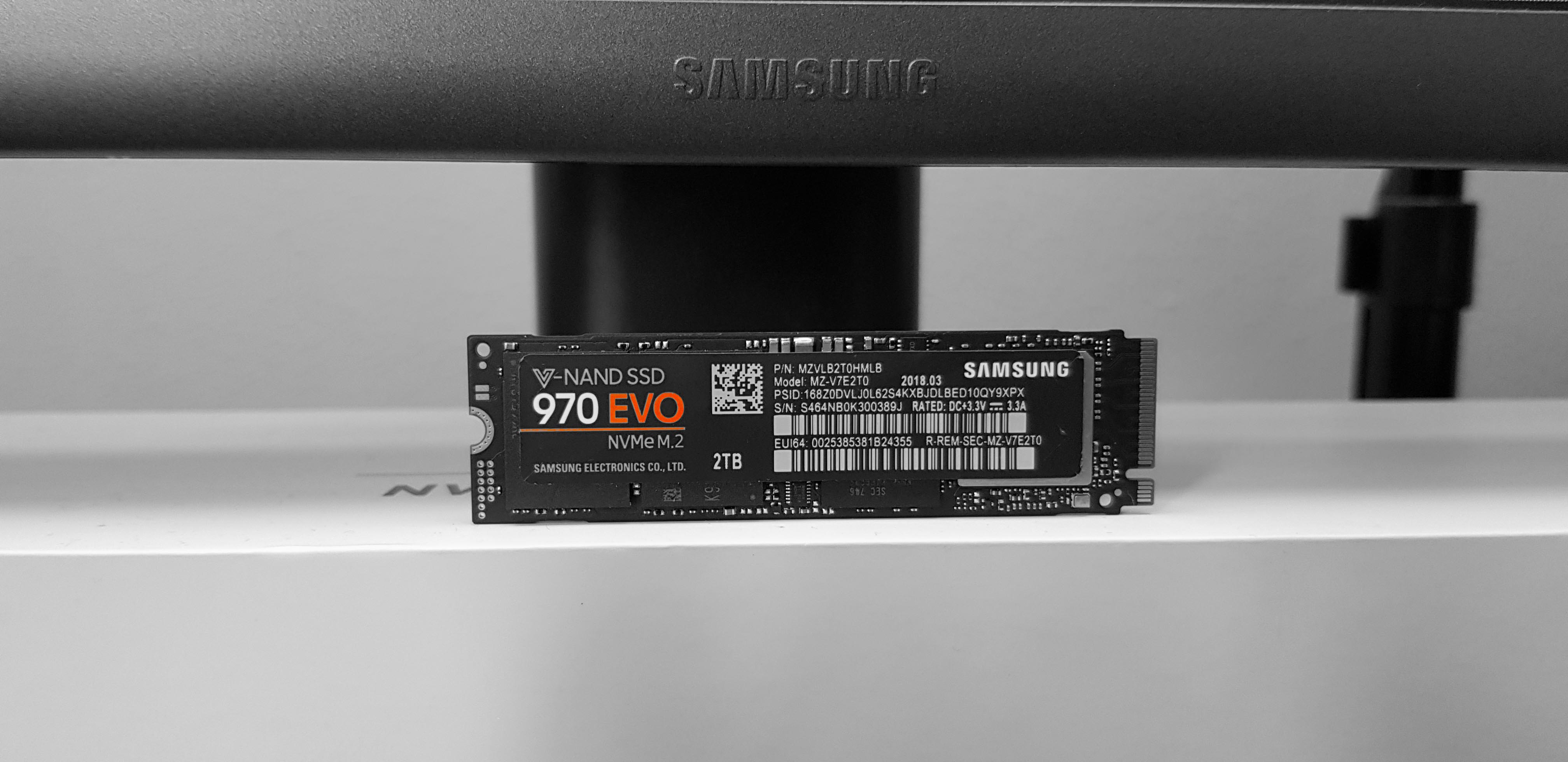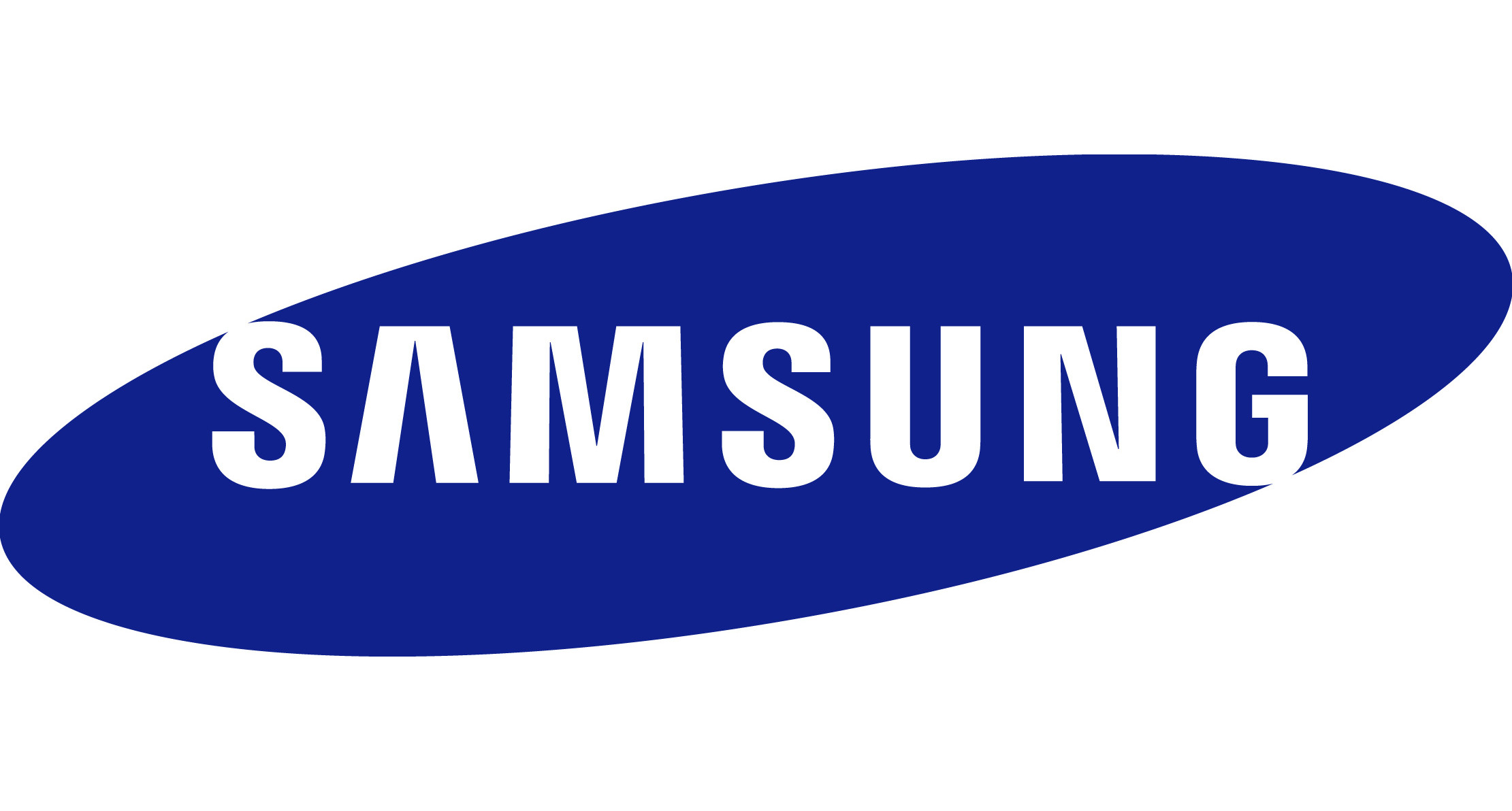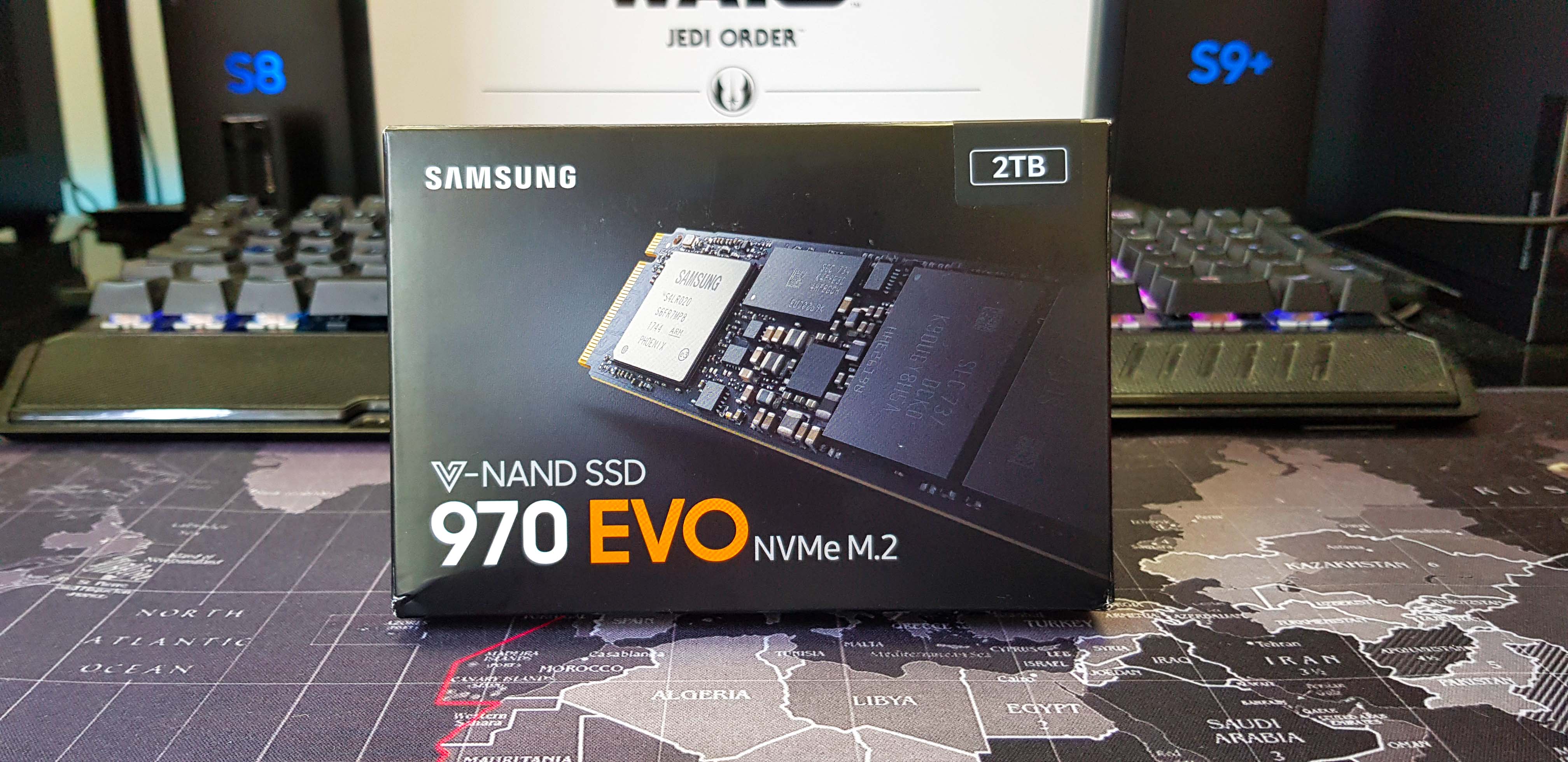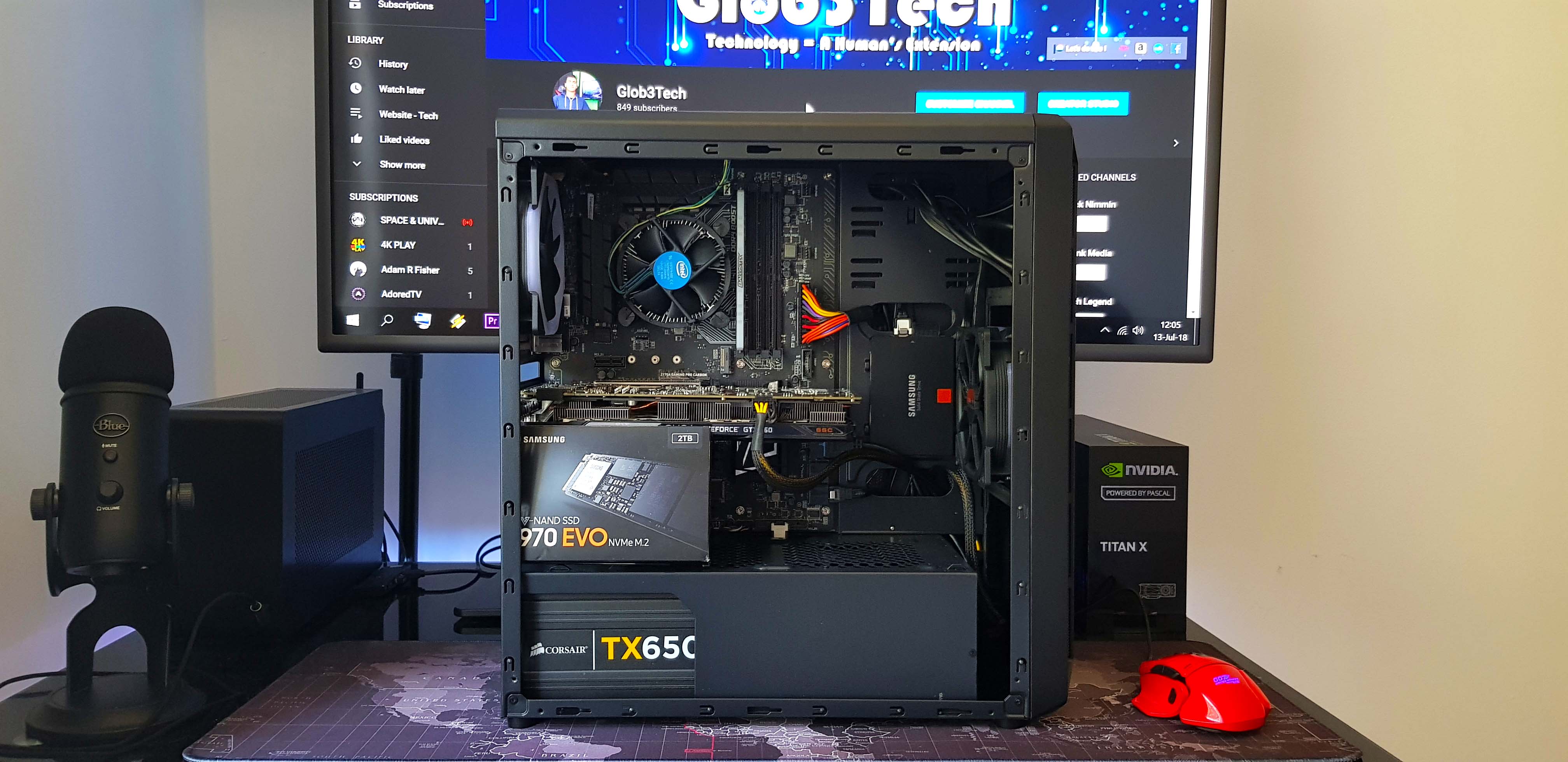
A couple of years ago, Samsung brought to the world the first 2 TB M.2 NVMe SSD - the 960 Pro - which cost much higher than the average consumer’s spending budget, at around $1300. Now, they are back with a new product with even more evolved tech that offers the same capacity but at almost half of the price.
This is the Samsung 970 EVO 2TB, the top dog from their new 970 EVO series which is the first consumer NVMe SSD to feature 512Gbit V-NAND. This doubles the 960 2TB Pro’s density which also was the first and biggest when it was released. This new density allows Samsung to fit 1TB of storage on a single sixteen die flash package meaning a single-sided 2TB M.2 SSD with a conventional two-package flash array is now possible.
So far, the price is more affordable, the product is also packing the newest tech but what about performance? Well, I’m glad you asked because with the 970 EVO 2TB we are almost approaching the limits of the of PCIe 3.0 x4 bus. This drive has a staggering peak read/write throughput of 3,500/2,500 MB/s, while random read/write performance shows numbers of up to 500,000/480,000 IOPS. The cherry on the top is manifested in the form of 1200 TBW of endurance -world record on the TLC SSDs.
Everybody knows Samsung:

Samsung is a South Korean multinational conglomerate company headquartered in Samsung Town, Seoul founder in 1938.
It comprises numerous subsidiaries and affiliated businesses, most of them united under the Samsung brand, and is the largest South Korean business conglomerate.
Notable Samsung industrial subsidiaries include Samsung Electronics (the world’s largest information technology company measured by 2012 revenues, and 4th in market value), Samsung Heavy Industries (the world’s 2nd-largest shipbuilder measured by 2010 revenues), and Samsung Engineering and Samsung C&T (respectively the world’s 13th and 36th-largest construction companies).
Other notable subsidiaries include Samsung Life Insurance (the world’s 14th-largest life insurance company), Samsung Everland (operator of Everland Resort, the oldest theme park in South Korea), Samsung Techwin (an aerospace, surveillance and defense company) and Cheil Worldwide (the world’s 15th-largest advertising agency measured by 2012 revenues).
Prices and Availability
The Samsung 970 EVO series features four models with capacities ranging from 250 GB all the way to the sample test of today, 2TB. We will use Amazon’s UK and US websites for price reference.
Amazon.co.uk:
Now via Amazon.com:
Presentation and Specification
We have a lot to discuss so don’t miss this chapter. First let’s entertain ourselves with another epic trailer from Samsung, a feature we have come to highly anticipate whenever they release a new SSD series.
Let’s see what’s new with the 970 series. We have already discussed in the intro that the new 970 EVO 2TB has the biggest V-NAND density at 512Gbit. Despite this V-NAND being a 64-layer 3-bit/TLC one, it is faster and more enduring than the previous generation. The 2TB proudly has a guaranteed endurance rating of 1200 TBW. Overall the endurance rating being increased by 50% at each capacity model over the 960 EVO and even more important the warranty has been risen from 3 to 5 years.
Performance metrics of up to 3,500/2,500 MB/s read/write throughput put the 2TB drive very close to the theoretical maximum bandwidth of the PCIe 3.0 4x slot.
Another key element is the new “Phoenix” NVMe controller which like its predecessor “Polaris” is a 5-core ARM-based processor. One core handles host communication while the remaining four take care of the drives NAND array. The new controller features increased core-clock speeds and enhanced thermal capabilities over previous generations.
Speaking of thermals, we all know by now that fast NVMe M.2 SSDs get really hot and they will thermal throttle periodically reducing a lot of overall performance. With the 970 EVO, the Phoenix controller is nickel plated allowing it to dissipate heat faster. Also this improved thermal performance delays the trigger point of Samsung’s Dynamic Thermal Guard (DTG) by 14 seconds in comparison to the 960 EVO which means you can write more data (~ 32 GB) before thermal throttling kicks in.
As per all TLC drives, most companies offer a supercharge function. Basically they have a very fast buffer that will offer far higher speeds than the native speeds of the TLC cells. Of course when this cache fills up, overall performance goes down. Samsung’s aproach is called Dynamic Intelligent TurboWrite. But since the 960 series they employed the concept of a two-tiered SLC buffer for even more advanced workload management.
The first row shows the EVO’s fixed buffer which is either 4GB or 6GB depending on the SSD’s capacity. With this buffer the random write traffic is taken care of. Even though its a small buffer, this should be sufficient even for heavy multitasking workloads. Then the second row is self explanatory - the second level of buffer, the dynamic Intelligent TurboWrite - this kicks in when you transfer a large file to the drive and expands if the drive has enough unused space. This is also proportional to the SSD’s capacity.
To wrap things up, these are the complete specs for the entire 970 EVO M.2 lineup.
The only new thing to point out is the new NVMe interface version which is at 1.3 now.
Packaging and visual inspection
The all black background and minimalist design is present once more in the new 970 series. Emphasis on the colors used to differentiate between the EVO series in orange and red for the PRO series. The capacity is on the top on the right hand side but not much else is provided. Samsung’s reputation proceeds them though so most likely you will know what this is and how … special, it is.
From the back just the warranty information is present.
Inside, the M.2 SSD is nicely secured in this plastic shroud.
The shroud is formed of two pieces and underneath the top part we have the manual.
Now for the golden apple. This is what the peak of today’s solid state drives in the M.2 format look like. From right to left underneath the sticker, we have the nickel plated “Phoenix” five-core 8-channel NVMe controller, a Samsung DDR4 2048MB DRAM package and two 1024GB 64-layer V-NAND 3-bit flash chips.
The luxury of technological advancements, this drive is single sided.
To put things into perspective, this is how compact the M.2 format is.
Right, let’s finally put it to the test.
Installation & Testing methodology
- Synthetic and real life tests.
- All test subjects have identical content.
- All SSDs were secure-erased before our tests started
- Steps have been taken to ensure that the CPU’s power-saving features don’t interfere with any of our results. All of the CPU’s low-power states have been disabled.
- In order to minimize random variation, each of the real-life performance tests are run a few times with reboots in-between tests to minimize the impact of disk cache.
- (SATA SSDs only) Make sure you use a SATA 6Gbps capable motherboard and a matching cable to avoid bottle-necking.
- Then double check in the BIOS that you have the AHCI mode activated for another maximum performance tip.
Hardware used:
- CPU: Intel i3 6100 @ 3.70 GHz - 2c/4t - 51W TDP
- Motherboard: MSi Z170a Pro Carbon Gaming ATX
- Boot SSD: Samsung 840 Pro 128 GB MLC
- RAM: 8GB DDR4 Crucial Ballistix Tactical Tracers RGB 2666 Mhz CL18
- Video card: EVGA GTX 960 SSC 2G ACX 2.0
- PSU: Corsair TX 650W ATX
- Case: CiT Blitz RGB ATX
It’s really easy to install, most motherboards today should have a dedicated M.2 slot. Insert the drive there and just make sure the notches align. Then screw it into place. Done. If you don’t have a dedicated slot or are on an older system, no worries, just get an adapter (link) and install it in any free PCI-E 4x-16x slot like so.
Competition and other storage subjects:
- Samsung M.2 950 Pro 512 GB MLC PCIe NVMe
- Samsung 840 Pro 128 GB MLC
- Western Digital Caviar SE 160 GB 7200 RPM 8MB
Basically we chose one candidate from each type of storage. Mechanical 3.5″ HDD, 2.5″ SATA SSD and an older generation M.2.
Software:
- Windows 10 Pro x64 Version 1803 OS Build 17134.165
- HD Tune Pro v5.00
- ATTO v3.05
- Crystal Disk Mark v6.0.0
- Anvil Storage Utilities v1.1.0
Samsung Magician Software
Speaking of software, let’s explore Samsung’s proprietary SSD application. They offer many apps, even an SSD migration wizard and NVMe Windows drivers (v3.0 with the new 970 EVO series, from V2.3 since the 960s). All of them are available for download from Samsung.
The front tab offers critical information for your Samsung SSDs like usage, S.M.A.R.T info and if you need to update the firmware. It even verifies if the drive is a genuine product from Samsung.
It also features a built in benchmark. All good here as well.
Other extra tinkering includes access to adjust the Over Provisioning, enable data security (the drive supports AES 256-bit full disk encryption, TCG/Opal V2.0, and Encrypted Drive ) and securely erase the drive.
Testing and Results
First, we start with HD Tune Pro – which is a hard disk / SSD utility with many functions. It can be used to measure the drive’s performance, scan for errors, check the health status (S.M.A.R.T.), securely erase all data and much more.
Here we have the Samsung’s 970 EVO 2TB speed results in the “Read” (left) and “Write” (right) benchmark.
We are mostly interested in the “average” value which gives us an idea of consistency. Notice the “dip” in performance when the cache fills up in the 970 EVO but still the overall numbers are pretty amazing. To have the full perspective, the 970 EVO 2TB drive is compared to the others in the following graph.
Moving to the next utility - Crystal Disk Mark – this one is designed to quickly test the performance of your drives. The program supports four tests: “Seq Q32T1″ (sequential read/ write with multiple threads and queues), “4K Q32T1″ (random read/ write with multiple threads and queues), “Seq” (sequential read/ write with a single queue and thread) and “4K” (random read/ write with a single queue and thread).
We see the full bandwidth is displayed for the “read” test in this benchmark for all test subjects.
Moving to the “write” test, we get the same hierarchy.
Then let’s take Anvil’s Storage Utilities – which is a powerful tool that was designed in order to provide you with a simple means of assessing the read and writer performance of your Solid State Drive or Hard Disk Drive. The benchmark tool helps you monitor and check the response time of your unit as well as view the system information collected using Windows Management Instrumentation (WMI).
It gives us a total performance index score.
To conclude the synthetic test, ATTO – is another performance measurement tool to test any manufacturers RAID controllers, storage controllers, host bus adapters (HBAs), hard drives and SSD drives.
Now for the file transfer tests.
A single file under the buffer’s limit, goes like a bullet.
Then with a folder comprised of thousands of various files, formats and sizes of around a total capacity of 50 GB, we see some oscillations but still we get an average over 1GB/s which is really good.
Time to dissect the numbers.
Analysis
With synthetic benchmarks, almost all of the time you will see the promised maximum theoretical speed available. No news there. When it comes specifically to writing data on drives such as the 970 EVO that have a buffer, when that fills up, we will see a “dip” aka a decrease in overall performance. On top of that we add the thermal throttle to finally see how it would perform in a busy mixed environment because, hey, that’s why you will buy such a specialized SSD.
When comparing all the data against anything else besides another top tier M.2 NVMe SSD, the 970 EVO 2TB decimates everything in its path. It beats the 950 Pro in the peak outputs by almost 1GB/s! Worth mentioning as well that the 950 Pro when among the rest of MLC Pro drives 960 & 970 will perform better only in the sustained average output because they don’t need the presence of any buffer (Turbo Write) since the MLC cells they posses are “genetically” capable of native high performance versus the TLC ones found in the EVO series.
With all the new technologies under the hood, the 970 EVO has a better overall thermal dissipation and management even without extra cooling. For example the 950 Pro’s throttling is very aggressive because it gets even bigger Celsius numbers in the operating temperature if no adequate cooling is provided.
Conclusion
There is no doubt about it, when it comes to M.2 SSDs, that Samsung is the overall leader in performance and progress. This gave them the right to be able to ask a lot of money for such advanced products in the past. Nowadays, thanks to more competition from brands such as WD, Crucial etc finally we have access to these SSD beasts within a more reasonable price range. Competition is alaways good for the end consumer.
Far too long we have been stuck in the dinosaur age of the conventional mechanical hard drive. With the M.2s like the 970 EVO 2TB we finally have seen the light and can experience bullet fast data transfers with out sacrificing an internal organ or two.
Despite being a TLC based SSD which needs the TurboWrite to have the quoted peak performance numbers, even with out the supercharge effect, there is no way to “feel” in a real world scenario without benchmarks to see if it is slower or not. This is all due to Samsungs continuous research and advancements with all the technologies built and developed in-house.
.
The Samsung 970 EVO at 2TB has all the bells and whistles from capacity, endurance ratings, pure sustained performance to make you accept the asking price, especially when compared to the 970 Pro at 1TB which cost almost the same. For 95% of consumers the 970 2TB is the rational and most practical choice in this tier level.
Backed up by a 5 years warranty, peak bandwidth numbers approaching the PCI-E 3.0 4x limits and a world record endurance rating for TLC cells, this is quite the product !
The good:
+ World leading endurance ratings for TLC at an official number of 1200 TBW
+ 5 Years warranty
+ Incredible overall performance for TLC cells
+ All the new technologies you can ask for from a 2018 M.2 SSD NVME (64 Layer V-NAND)
+ All in house developed technologies for the cells, controller and firmware
+ Full software support from Samsung
+ Single sided format
The bad:
- The 2TB model is an expensive piece of kit but it all depends in which context you put it
- Needs Turbo Write to achieve peak performance quoted levels, a technology dependant on the buffer size
Glob3trotters “Epic” Award 4.5 out of 5


































